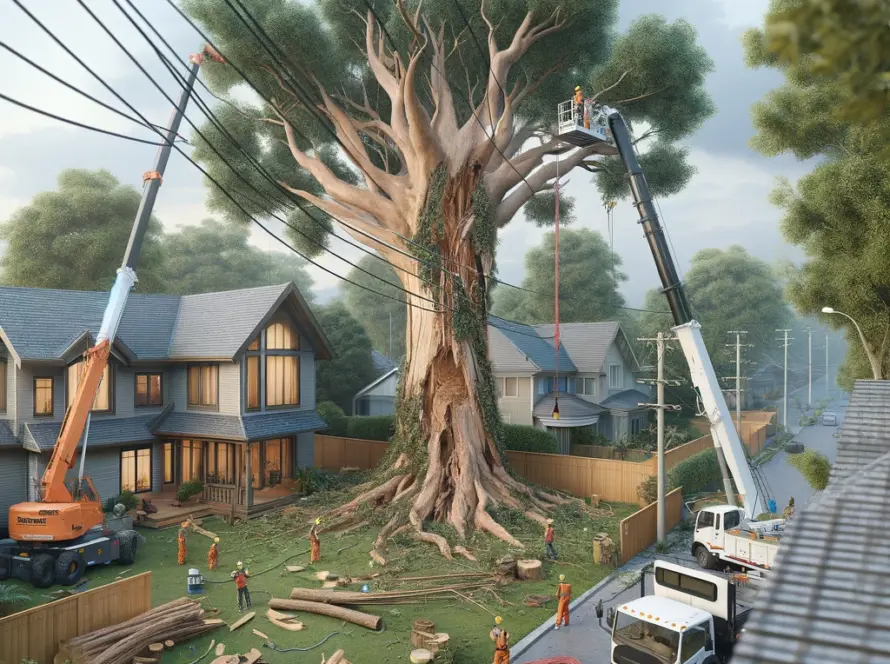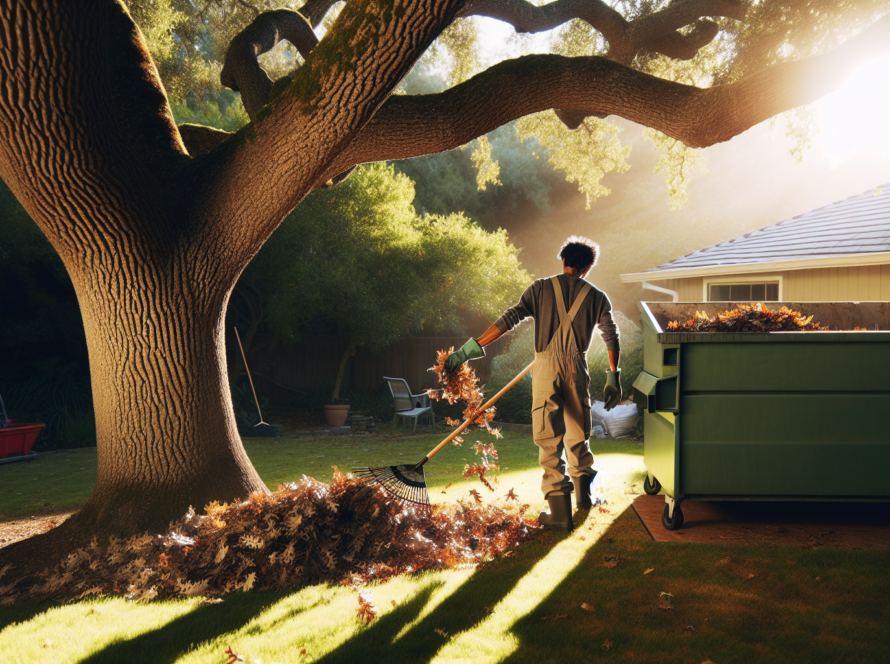Girdling a tree can be deliberate for habitat management or accidental with damaging results. This guide explains the what, why, and how of tree girdling, the balance between its use and misuse, and the methods for dealing with unavoidable damage. Whether you’re a practitioner or a homeowner, understanding tree girdling starts here.
Key Takeaways
Tree girdling is a practice with multiple purposes that can either be done intentionally to manage forests, create wildlife habitats, and clear areas for development or can occur accidentally, often due to negligence or improper care of trees.
Proper timing and techniques are crucial for effective tree girdling — it’s typically most successful after new growth and requires maintenance to prevent the tree from healing. Protective measures against accidental girdling include removing or adjusting material around the growing tree and protecting against lawn equipment damage.
While girdling can be severely detrimental, leading to restricted nutrient flow and tree decline, it’s possible to save girdled trees through methods like bridge grafting and addressing root issues. However, girdled trees can impact ecosystems by providing habitats for wildlife and presenting potential hazards as they decay.
The Purpose and Process of Tree Girdling
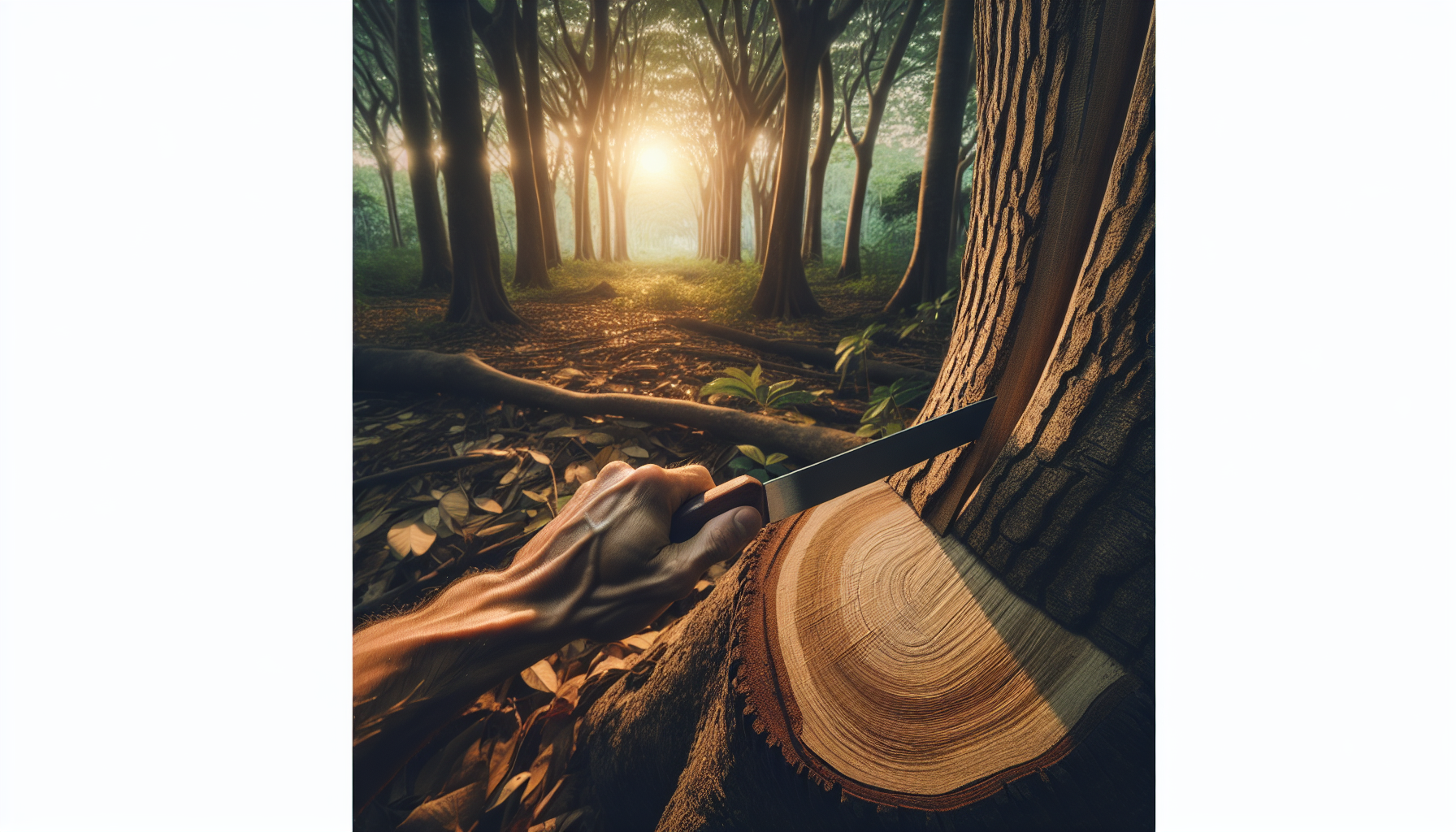
At first glance, it may appear that tree girdling, involving the removal of a strip of bark around a tree’s circumference, is detrimental to the tree. After all, it eventually causes the tree to starve by preventing nutrient flow. However, tree girdling serves various purposes such as managing forests, creating habitats for wildlife, and clearing areas for developmental activities.
When a tree is girdled, there is minimal disruption to the light available for undergrowth, supporting the growth of plants, such as cranberries and blueberries. The intriguing process of tree girdling can be intentional or accidental, each with its unique set of techniques, timing, and conditions. In the following sections, we will delve into:
intentional tree girdling techniques
accidental tree girdling and its effects
timing considerations for tree girdling
conditions that favor successful tree girdling
Intentional Girdling Techniques
Intentional tree girdling methods are as varied as the trees themselves. These methods include:
Ring barking: involves the removal of bark from around the circumference of a tree’s limb or trunk and is used in fruit production to decrease shoot vigor.
Cut-and-ring: involves making a cut through the bark and into the wood, then removing a ring of bark.
Overlapping cuts: involves making multiple cuts around the circumference of the tree, overlapping each cut slightly.
These methods are used for various purposes, such as controlling tree growth or promoting fruit production.
On the other hand, the cut-and-ring method requires making three chainsaw cuts around the trunk to sever the bark and cambium layer, or cutting and stripping a 6-8 inch band of bark around the trunk with various tools. Variations of cut-and-ring, like frilling, involve cutting overlapping slashes into the trunk, with the effectiveness boosted by multiple bark rings or thicker bands to prevent bark regrowth.
Timing and Conditions for Effective Girdling
Just like in life, timing is everything when it comes to successful tree girdling. Girdling is most effective when performed after a tree’s new growth phase when its stored carbohydrates are depleted but before it enters dormancy. Late spring, particularly around the beginning of June, is considered the optimal time for girdling as the cambium layer is active, making the bark easy to remove.
However, girdling isn’t a one-time task. It requires maintenance even after the initial process. During less ideal conditions such as dry summer or winter, girdling requires more effort to chop through tight bark, and a sufficiently wide band must be removed to prevent the tree from healing itself.
Post-girdling maintenance is necessary to remove any sprouts and prevent the cambium from regenerating bark, ensuring the tree does not regrow the girdled section.
Unintentional Tree Girdling: Common Causes and Prevention
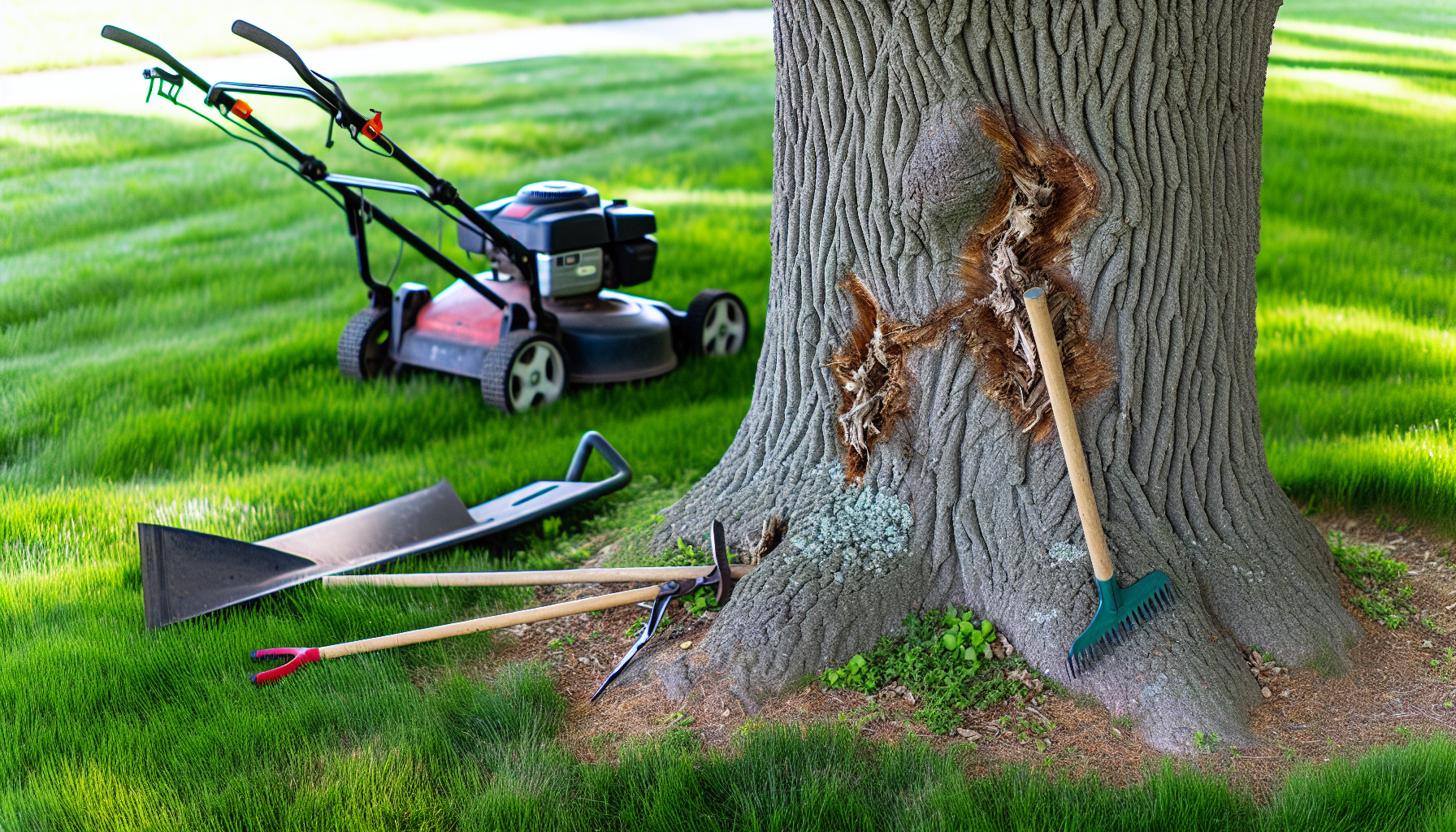
While some tree girdling is intentional, other cases occur accidentally, often due to negligence or a lack of understanding about how trees grow. The most common accidental tree girdling is caused by guy wires or straps installed during planting and by ropes or wires left around trees after being used for various purposes.
To prevent accidental girdling, it’s essential to adjust or remove staking straps and materials as the tree grows, ensuring they are loose enough to allow for natural movement. However, ropes and wires aren’t the only culprits. Lawn equipment, such as lawnmowers and string trimmers, can damage tree bark if used too close to the tree base, potentially causing girdling.
Even harmless-looking materials like ribbon or strings can cause significant damage to the tree trunk and should be removed to prevent girdling.
Lawn Equipment Damage
Lawn equipment may seem innocuous, but in the hands of an unaware gardener, they can wreak havoc on your trees. Lawn equipment such as lawnmowers and string trimmers can cause severe damage to tree bark sufficient to choke off the tree’s nutrient supply and girdle the tree. As such, establishing protective measures is crucial to prevent the damage caused by lawn equipment that can lead to tree girdling.
One effective preventive measure is the use of mulch. Spreading mulch around the base of a tree creates a safety zone that keeps lawnmowers and string trimmers at bay. Additionally, barriers around the trunk provide a physical shield against inadvertent damage.
So, the next time you’re out trimming your lawn, take a moment to consider the safety of your trees as well.
Avoiding Harmful Materials
While ropes and lawnmowers are apparent threats to trees, some harmful materials might not be as evident. Items like:
bird feeder hooks
swings
nylon twine
zip lines
Christmas lights
ribbon
tree identification tags
can girdle tree trunks or branches and should be maintained or removed to prevent damage.
Materials like burlap, wire baskets, or twine left around the trunk of a newly planted tree can lead to girdling as the tree grows, and straps used to secure trees should be properly adjusted or removed as the tree grows. Even when labeling trees, it’s advisable to use a label that is suspended loosely from the tree to avoid girdling.
Remember, the smallest things can make the biggest difference when caring for your healthy tree, especially when it’s a young tree.
Recognizing Girdled Trees: Symptoms and Signs
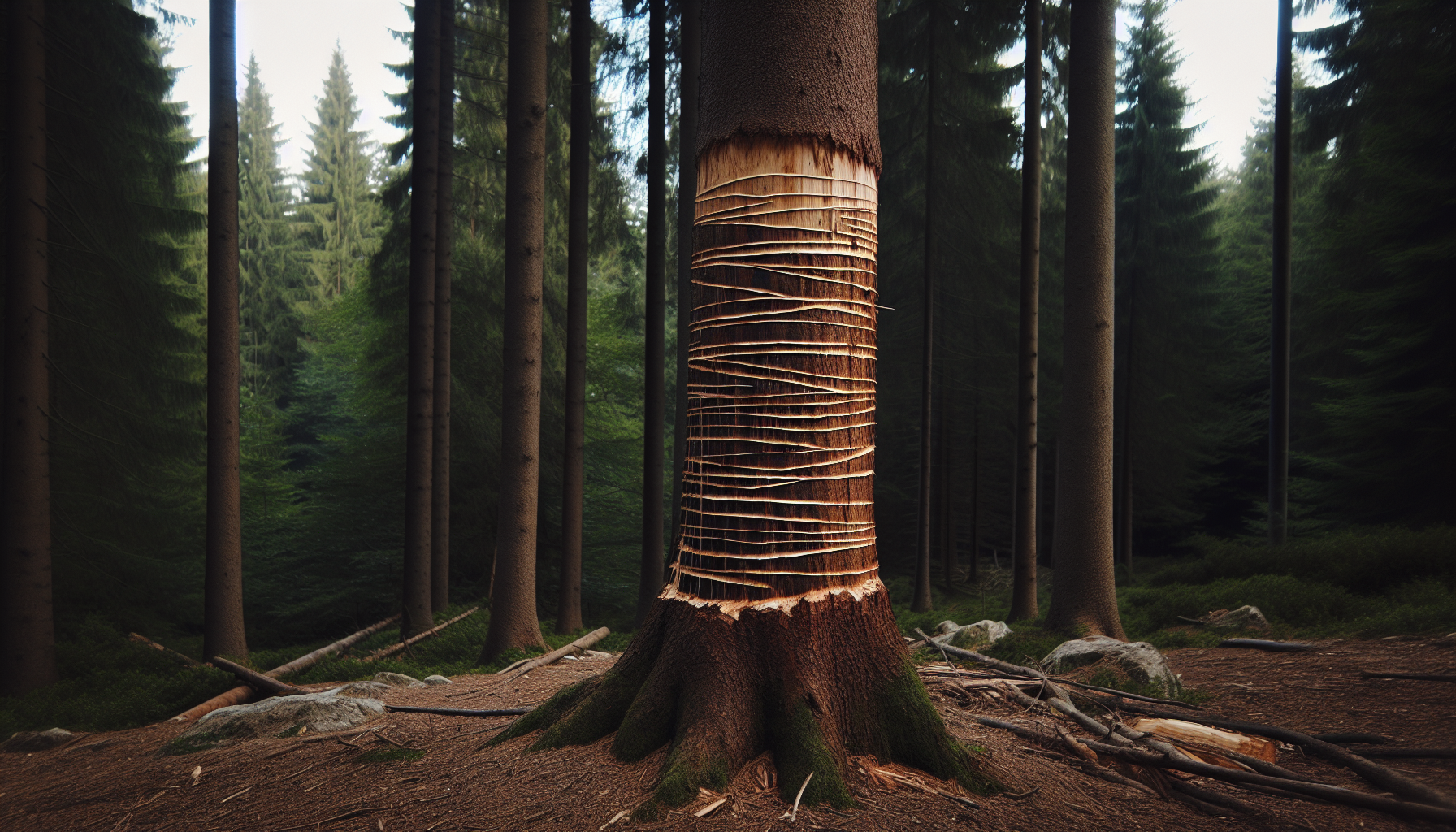
Recognizing a girdled tree early can mean the difference between life and death for the tree. But what are the signs? Here are some signs to look out for:
A tree trunk with no visible flare at its base entering the ground like a telephone pole suggests the presence of girdling roots.
Stunted branch growth
The development of fall color too early
Circular root growth patterns
Girdling roots restrict water and nutrient flow, which can lead to tree decline over several years. Some species, like:
Norway maple
Red and sugar maples
American beech
Pines
Oaks
Poplars
Elms
are especially vulnerable. However, the signs of girdling aren’t always clear-cut. They can manifest in visible trunk damage and changes in foliage and canopy, which we will explore in the following sections.
Visible Trunk Damage
Visible trunk damage on a tree can be a clear indicator of girdling. This damage can be observed as a deep cut around the trunk, approximately 1-2 inches wide and nearly an inch deep, exposing the underlying wood. Additionally, strangulation marks on the trunk or branches from overly tight tree stakes, straps, or the tree’s own roots indicate a clear sign of girdling.
However, not all signs of girdling are above ground. When one side of the trunk appears straight without a natural flare at the base, girdling roots may be present below the soil surface, requiring excavation to confirm. So, the next time you’re inspecting your trees, remember to check both above and below the ground.
Foliage and Canopy Changes
Changes in a tree’s foliage and canopy can also signal girdling. Affected trees may exhibit:
Leaves that are lighter green
Scorched leaves
Early fall color
Premature leaf drop
Stunted branch growth
Premature development of fall color
Twig or large branch dieback
These symptoms indicate a compromised root system.
In some cases, localized dead spots at the tree’s crown can be a consequence of girdling roots. This has been observed with sweet gum trees. By keeping a watchful eye on your trees’ foliage and canopy, you can catch girdling early and potentially save the tree.
Saving a Girdled Tree: Remedies and Recovery
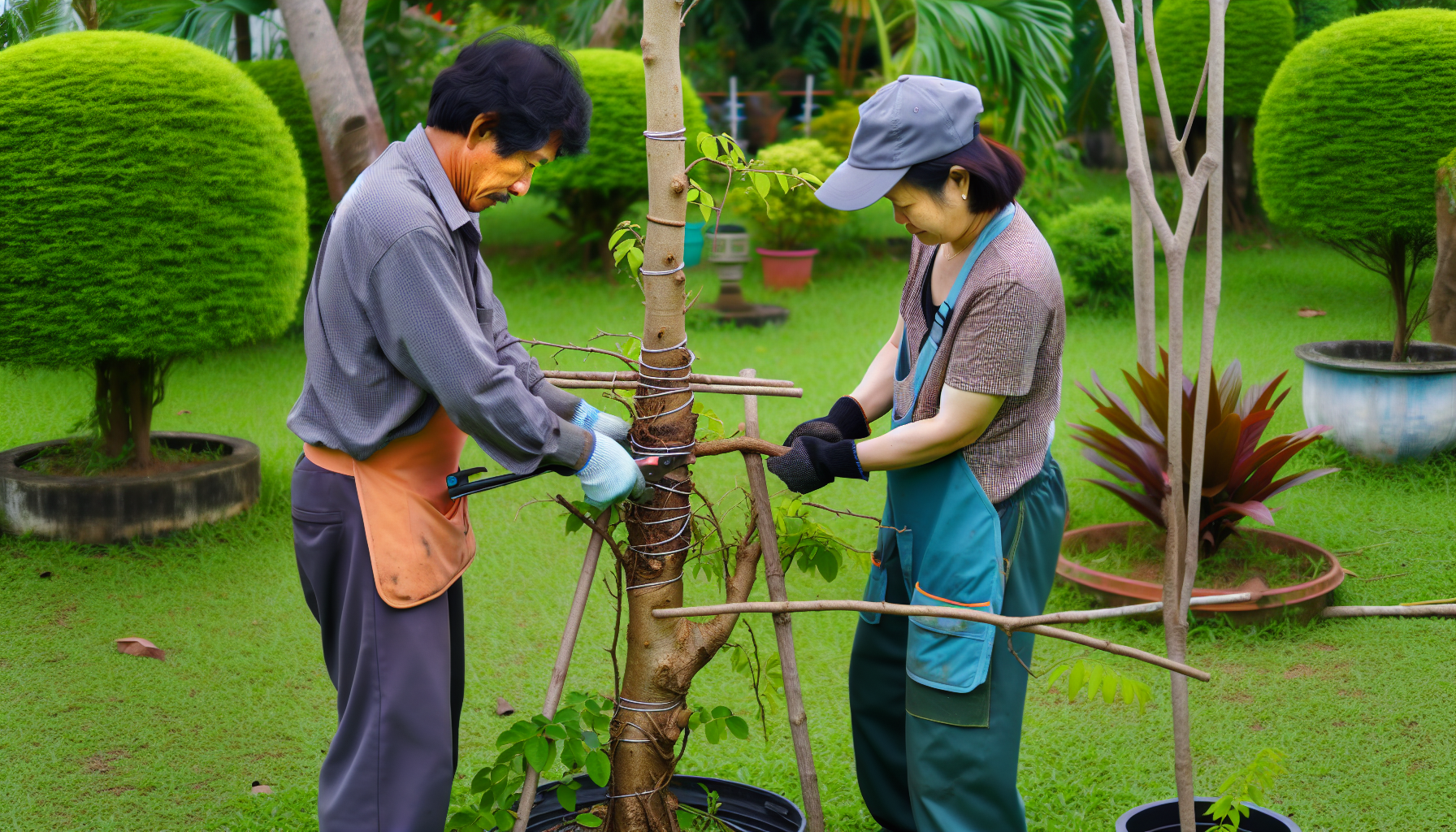
While girdling can be damaging, it’s not always a death sentence for a tree. There are remedies that can help a girdled tree recover. One such remedy is bridge grafting, a process that can restore the flow of water and nutrients to the tree by creating a “bridge” over the girdled part.
The process of bridge grafting involves collecting scion wood, cleaning the wound, creating flaps in the bark, and inserting the prepared scion wood under the flaps. After the graft connections are made, they are covered with a grafting compound or wax to preserve moisture and protect grafts from infestation and disease. But it’s not just about bridge grafting. Other methods of saving a girdled tree include removing girdling materials and addressing root issues, which we will discuss in the following sections.
Removing Girdling Materials
Removing girdling materials is a crucial step in saving a girdled tree. Materials such as:
burlap
wire baskets
twine left around the trunk of a newly planted tree
strings
ropes
chains
climbing vines that wrap around the trunk and grow thicker
Girdling can affect various tree species, including the Douglas fir, and may eventually remove trees from the landscape as the tree begins to weaken and die.
Removing these materials is essential to prevent them from cutting further into the tree’s bark or tightening as the tree grows. Even if a guy wire or other girdling material is found embedded in a tree stem, careful removal can result in significant tree recovery.
After removing girdling materials, it’s important to monitor the tree to ensure it is showing signs of recovery and not being affected by any remaining or regrown girdling agents.
Addressing Root Issues
Addressing root issues is another essential step in saving a girdled tree. Planting a tree at the proper depth promotes healthy root development and can prevent girdling roots. When planting, it is essential to dig a wide planting hole, loosen and straighten circling roots, and avoid compacting the sides to prevent root deflection and girdling.
Young trees with girdling roots due to being planted too deep should be replanted at the correct depth, with circling roots cut. When dealing with circling roots in container-grown trees, it is recommended to make several 2-inch deep slices from the top to the bottom of the root ball in 3 to 4 locations. This can help to redirect the roots and promote healthy growth. In severe cases, circling roots that tighten and stop the flow of water and nutrients should be severed, with small roots removed using a chisel and large roots notched or consulted over with an arborist. To prevent these issues, it’s essential to be aware of the roots circle and take proper care during planting.
The Impact of Girdled Trees on Wildlife and Ecosystems
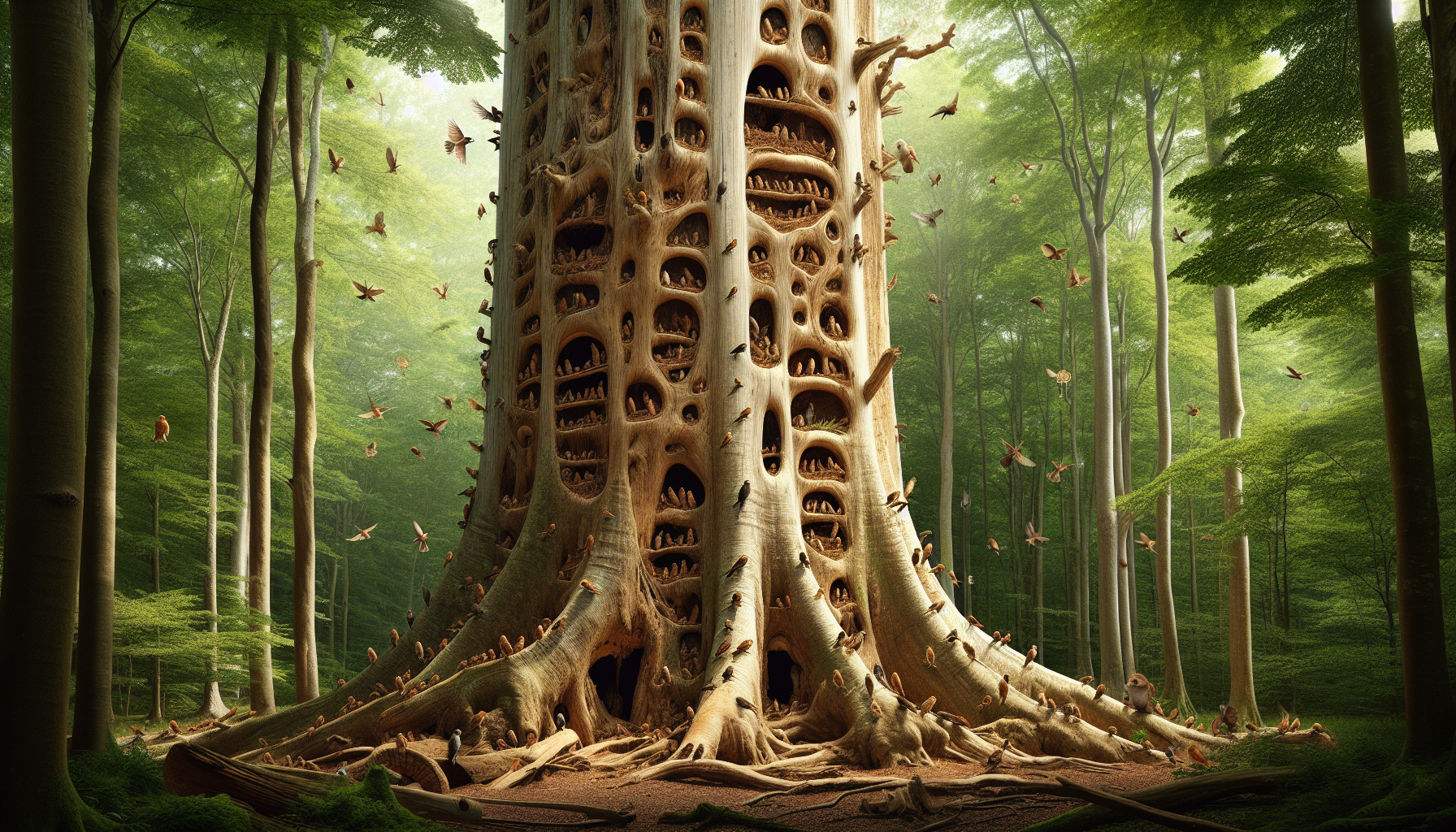
Girdled trees have far-reaching impacts on ecosystems. They create new habitats and pose potential risks. Standing deadwood habitats formed from girdled trees provide shelter and nesting grounds for a variety of species. However, girdled trees can also present hazards, such as falling branches or whole tree collapse, which may threaten human safety and environmental integrity.
From providing a home for birds to posing a risk to nearby infrastructure, girdled trees play a significant role in our ecosystems. Let’s delve deeper into the benefits for wildlife and the potential hazards and environmental concerns associated with girdled trees.
Benefits for Wildlife
Girdled trees play a crucial role in supporting wildlife. They create habitats for a wide variety of species including mammals, birds, and insects, contributing to forest health and diversity. Birds that require dead standing trees, such as woodpeckers, benefit from girdled trees as they use them to construct nests and store food.
Even large game animals, like moose, benefit from the ease of navigation that standing dead trees offer, making girdled trees advantageous for their movement in a forest setting. Girdling trees is an intentional forest management practice that creates standing dead wood, which is essential for maintaining diverse forest habitats.
Potential Hazards and Environmental Concerns
While girdled trees provide benefits for wildlife, they also present potential hazards. Girdled trees, also referred to as snags or widowmakers, present a risk of collapse, which can vary in time depending on the species; for example, pine trees might fall within 5–8 years from girdling.
It is crucial to ensure girdled trees are in a safe area to prevent them from posing a threat to nearby buildings, infrastructure, or people as they weaken over time. When girdling trees near property lines, it is important to be aware of the legal implications and potential damages if the tree falls and crosses into neighboring property.
Summary
From the intentional girdling techniques that manage forests and create wildlife habitats to the unintentional girdling that can harm a tree’s health, tree girdling is a complex process that plays a vital role in our ecosystems. It’s a process that requires understanding and careful management to prevent harm and promote benefits. With the knowledge shared in this post, you are now equipped to recognize, prevent, and even cure tree girdling, ensuring the health and longevity of your trees and contributing to the richness of our ecosystems.
Frequently Asked Questions
Can a tree survive being girdled?
Yes, a tree can survive being girdled if less than half of its circumference is affected by the girdling. This is because a diminishing supply of water and nutrients can lead to a death spiral for the tree.
What is the difference between ringing and girdling?
While both ringing and girdling involve removing phloem and cambial tissue, girdling also removes xylem tissue, which has a more immediate impact on the plant’s transpiration and can lead to rapid wilting and tissue death. Girdling is typically done before flowering, while ringing is done after the fruit is set to promote faster fruit growth. Overall, both practices can have a significant effect on the physiological processes of the plant.
Is it safe to girdle a tree?
Girdling a tree is not safe, as it will eventually lead to the tree’s death and decline in health. It is important to avoid girdling, especially in areas with frequent use or with future commercial harvest plans.
What is the purpose of girdling?
Girdling is a technique used to kill woody plants by cutting through the bark in a strip around the stem, severing the nutrient flow and causing the plant’s death. It is often used to remove undesirable trees or shrubs.
What are the signs of a girdled tree?
If you notice a tree trunk with no visible flare at its base, stunted branch growth, early fall color development, and changes in foliage and canopy, your tree may be girdled. Look for these signs to identify a girdled tree.



